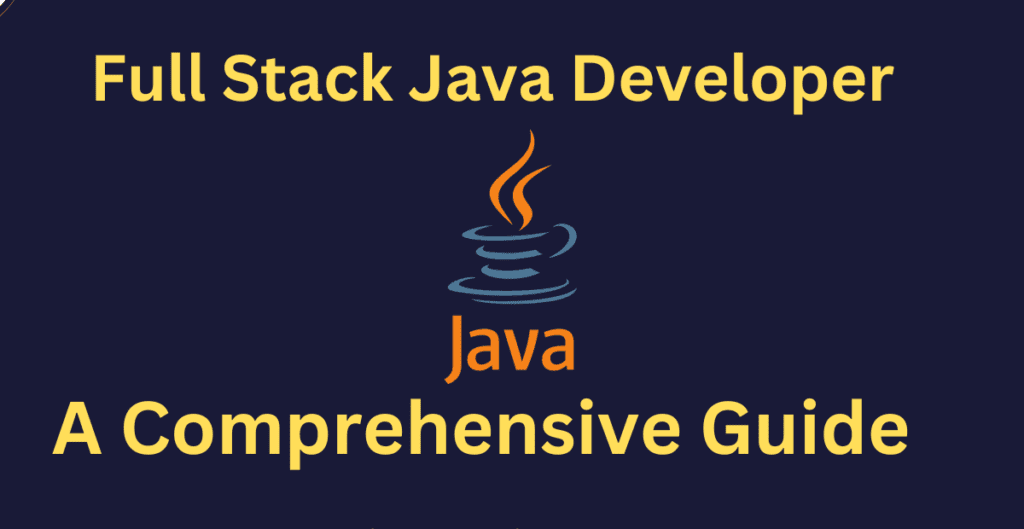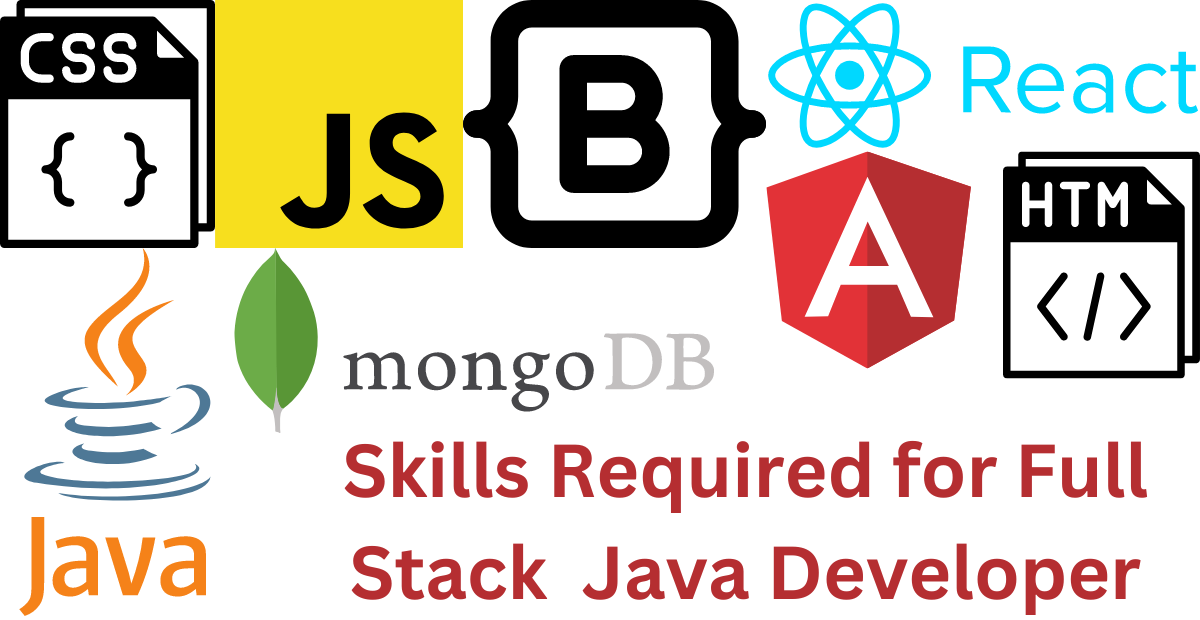If you want to know how to become a Full Stack Java Developer, your search ends here. In this article I will guide you to choose the right path for becoming a Full Stack Java Developer.
Since the technical industry is so dramatic today full stack Java developers are highly in demand just because of their ability to work on both the front-end and back-end of web applications. They possess a special skill set that allows them to build robust and seamless web applications.
In this comprehensive guide, I will take you through the essential steps and skills required to excel in this exciting field.

What is Full Stack Development? Why is it Important?
Full stack development refers to the ability to work on all aspects of web application development, from designing the user interface to managing the server-side logic and databases. Full stack Java developers are versatile and they can handle end-to-end development efficiently. They can work on all layers of a web application, from the user interface (UI) to the database and everything in between. It leads to faster project completion and improved collaboration between development teams.
Building a Strong Foundation with Java
The journey for becoming a full stack Java developer begins with mastering the fundamentals of the Java programming language. Start by understanding variables, data types, control structures, and object-oriented programming (OOP) principles. Practice core java coding exercises and work on small projects to enhance your Java skills.

Delving into Front-End Development
Front-end development focuses on creating the visual aspects and user experience of web applications. For becoming full stack Java developer, you should be proficient in building the user interface and user experience of web applications. This involves using technologies such as HTML, CSS, and JavaScript, along with frameworks like Angular, React, or Vue.js to create interactive and responsive UI (User Interface) components.
Here are the three essential front-end technologies that you need to learn for becoming a full stack Java developer.
HTML for Structuring Web Content
HTML is the backbone of web pages. You should learn how to use HTML elements, tags, and attributes to create the structure and layout of web pages. Practice creating basic web page structures to get a hands-on experience.
CSS for Styling Web Pages
CSS (Cascading Style Sheets) is responsible for styling and formatting HTML elements. Learn about CSS selectors, properties, and how to apply styles to different HTML elements. Experiment with CSS to design visually appealing web pages.
JavaScript for Interactivity and Functionality
You can create dynamic web pages with JavaScript. JavaScript is used to add interactivity and dynamic functionality to web pages. Learn about variables, functions, DOM manipulation, and event handling in JavaScript. Practice coding interactive features to make your web pages come alive.
Navigating Java Back-End Development
Back-end development handles server-side logic and database management. For becoming full stack Java developer you should be skilled in server-side programming using Java and Java-based frameworks like Spring or Java EE (Enterprise Edition). You should learn implementing the business logic, handling server-side processing, managing databases, and dealing with server-related tasks.
You must explore popular Java web frameworks like Spring and Java EE.
- Understand the concepts of server-side programming and learn how the back-end interacts with the front-end.
- Learn a back-end Java framework like Spring or Java EE, which simplifies development and provides features like dependency injection, MVC pattern, and security.
- Practice building server-side applications, handling HTTP requests, and processing data.
Creating RESTful APIs with Spring Boot
Understand REST (Representational State Transfer) principles and how to design RESTful APIs. Learn about API endpoints, request methods, and response formats. RESTful APIs enable communication between the front-end and back-end of web applications. Learn to use Spring Boot, a lightweight framework that makes creating RESTful APIs in Java quite simple. Develop and test APIs to understand their role in connecting the application components.
Database Management and Design
Databases are integral to web development. Learn about database models, normalization, and SQL (Structured Query Language). Implement database operations using Java and frameworks like Hibernate to interact with the database. Acquire knowledge of relational databases and SQL. Learn how to design database schemas, perform CRUD (Create, Read, Update, Delete) operations, and optimize database queries.
Connecting the Dots-Integrating Front-End and Back-End
This stage involves integrating the front-end and back-end components to create a cohesive web application. Understand how API endpoints are called from the front-end to fetch and display data from the back-end. Practice creating API calls and handling responses.
Exploring Additional Full Stack Technologies
To enhance your full stack Java development skills, explore additional technologies like version control systems (e.g., Git), cloud-based deployment, and other front-end frameworks (e.g., React, Angular). Stay updated with the latest tools and trends to remain competitive in the industry.
Best Courses You Can Join for Becoming Full Stack Java Developer
If you are interested in becoming full stack Java developer and looking for some online courses then I must say that there are various online platforms that are offering excellent courses for becoming a full-stack Java developer. However, keep in mind that the content of online courses is continuously changing, and new platforms and courses are also being emerged. Here are some well-regarded platforms that offer quality full-stack Java development courses:
- Udemy: Udemy is known for its extensive collection of courses on various subjects, including full-stack Java development. You can check for courses taught by experienced instructors with good ratings and reviews.
- Coursera: Coursera collaborates with top universities and institutions to offer high-quality courses. You can find comprehensive full-stack Java development courses and specialization programs here also.
- edX: Similar to Coursera, edX partners with universities to provide courses in various disciplines. They have courses on Java development, web technologies, and full-stack development.
- Simplilearn: Simplilearn is also a learning platform that is getting popular these days. It offers a full and extensive course that can help you for becoming a full stack Java developer. You can earn certificates also that can boost your career like anything.
- Pluralsight: Pluralsight is an online learning platform with courses on software development, including full-stack Java development.
- LinkedIn Learning (formerly Lynda.com): LinkedIn Learning offers courses on a wide range of topics, including full-stack Java development, taught by industry professionals.
- Codecademy: Codecademy focuses on interactive coding exercises and projects. Although it may not offer a full-fledged full-stack Java course, it has excellent courses on Java and related technologies.
- Spring Framework Guides: If you specifically want to learn about Spring (a popular Java framework for building web applications), the official Spring documentation provides comprehensive guides and tutorials.
Also Read: https://tech-myarena.com/top-7-ai-writing-tools-for-content-efficiency/
Conclusion
Becoming a full stack Java developer is an exciting and fulfilling journey. By mastering Java fundamentals, front-end and back-end technologies, and continuous learning, you can fulfill your dream of becoming a full stack Java developer. This will make you able to create powerful web applications and make a significant impact in the tech industry. Embrace the challenges, stay curious, and never stop learning as you embark on this rewarding career path.
People also ask:
Q1) Can a Java developer be a full stack developer?
Ans) Yes. A Java developer can certainly become a full-stack developer. A full-stack developer posses the ability to work on both the front-end (client-side) and back-end (server-side) of web applications. As a Java developer, if you also possess the necessary skills and knowledge in front-end technologies and frameworks, you can easily become a full stack developer.
Q2) Is full stack java developer a good career?
Ans) Yes. Becoming a full-stack Java developer can be a rewarding and promising career option. Full-stack Java developers possess a versatile skill set that allows them to work on both the front-end and back-end of web applications, that makes them highly suitable in the job market.
Q3) What is the approximate salary for full stack Java developers in India?
Ans) The approximate salary breakdown based on experience levels in India is:
- The salary for entry-level developers can range from ₹3 lakh to ₹6 lakh per annum (approximately $4,000 to $8,000).
- Mid-level developers with 2-5 years of experience may earn around ₹6 lakh to ₹12 lakh per annum (approximately $8,000 to $16,000).
- Experienced/Senior developers with 5+ years of experience can earn around ₹12 lakh to ₹20 lakh or more per annum (approximately $16,000 to $27,000).
Q4) What is the roadmap for becoming a full stack Java developer?
Ans) The roadmap for becoming a full stack Java developer requires to learn:
- Java Fundamentals
- HTML, CSS, and JavaScript
- Front-End Frameworks
- Back-End Development
- Database and SQL
- RESTful APIs
- Version Control
- Testing
- Security
- Frameworks and Libraries
- Deployment and Hostin
- Continuous Learning and Projects
- Stay Updated
- Collaborate and Network
Q5) What are some good books to read for becoming a full stack Java developer?
Ans) For becoming a full stack Java developer, you can follow these books:
Fantastic site A lot of helpful info here Im sending it to some buddies ans additionally sharing in delicious And naturally thanks on your sweat
Your blog is a treasure trove of valuable insights and thought-provoking commentary. Your dedication to your craft is evident in every word you write. Keep up the fantastic work!
Real Estate There is definately a lot to find out about this subject. I like all the points you made
Fourweekmba I truly appreciate your technique of writing a blog. I added it to my bookmark site list and will
Thank you for the auspicious writeup It in fact was a amusement account it Look advanced to more added agreeable from you By the way how could we communicate
Insanont This was beautiful Admin. Thank you for your reflections.
Mangaclash This is my first time pay a quick visit at here and i am really happy to read everthing at one place
Nice blog here Also your site loads up fast What host are you using Can I get your affiliate link to your host I wish my web site loaded up as quickly as yours lol
Ezippi Very well presented. Every quote was awesome and thanks for sharing the content. Keep sharing and keep motivating others.
Thanks a lot.
Thanks I have just been looking for information about this subject for a long time and yours is the best Ive discovered till now However what in regards to the bottom line Are you certain in regards to the supply
Noodlemagazine Impressive post! We’ll be linking to this especially fantastic piece on our platform. Keep delivering excellent content
FlixHQ First time visiting, and I’m really happy to read everything all together in one place
Thank you for your sharing. I am worried that I lack creative ideas. It is your article that makes me full of hope. Thank you. But, I have a question, can you help me?
Hello my loved one I want to say that this post is amazing great written and include almost all significant infos I would like to look extra posts like this
Thanks for sharing. I read many of your blog posts, cool, your blog is very good.
Thank you for your sharing. I am worried that I lack creative ideas. It is your article that makes me full of hope. Thank you. But, I have a question, can you help me?
Thanks for sharing. I read many of your blog posts, cool, your blog is very good.